Consumption: six myths to discard
An article for the Fair Design conference, Warsaw, Poland, May 2018
Please note: parts of the argument here will appear in The Wiley-Blackwell handbook of design and innovation 2030, forthcoming
LIKE THE LIBERAL LEFT, MANY DESIGNERS SUFFER FROM SELF-DELUSION. Many are content with a great amount of orthodoxy in design, and especially in design education; only rarely are critiques made of fundamental and longstanding premises. (1) So let us critically examine six orthodoxies contained in the Theme for this conference, orthodoxies that are in fact myths. (2)
Designers need always to question what is taken as given in the theory of design. After all, in design, we often do not accept ‘the problem as given’. That’s one of the great things about the discipline.
Myth 1: We suffer from excess and ‘stuffocation’
For those fond of spreading this myth, impressions speak volumes. But the idea that we all own too much, and too much stuff in particular, may say more about the lifestyles of middle-class commentators in the West than it does about those of the vast majority of the world’s population.
Take housing. Are our houses really excessive? Are they too large, for instance? In the US, which has, with Australia, the world’s largest houses, sizes are in decline. For the 800,000 detached or semi-detached new homes in America completed in 2017, the median size was down to 225 m2, after an all-time high of 229 m2 in 2015; sizes also fell in and after the 2008 recession, as did the size of new flats or developments in which multiple families shared common facilities (2017 completions: 360,000). (3)
Endlessly bigger homes are by no means a given in the US economy.
The typical American home is relatively spacious. But if we go to Britain, conditions are much more cramped. In the London borough of Barnet, plans drawn up in 2017, to turn the council’s housing department into more than 250 flats, envisaged them as much smaller than the UK national space minimum of 37 m2 for a person living alone. The smallest homes, indeed, were going to be just 16 m2. (4)
Britain’s houses are getting smaller. As late as the 1970s, the average British home spread out over 55 m2. Today, that figure is down to about 47 m2: (5)
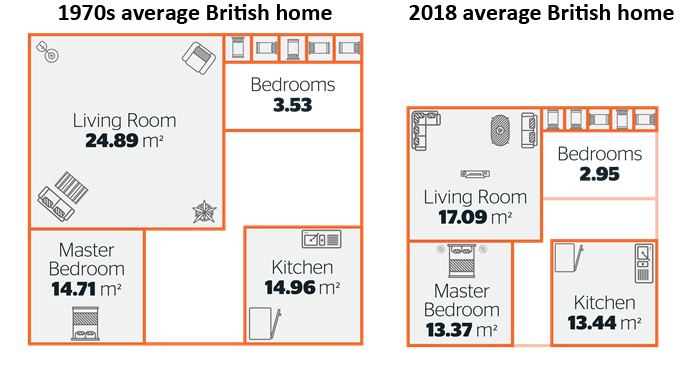
Families in Britain don’t at all enjoy an excess of space. And it is a similar story elsewhere. As Dr Szymon Hanczar points out in his conference paper Managing Needs – “13 m2”, small 12-16 m2 flats have been around in countries such as Germany, and in Wroclaw, Poland, since the 1990s. The downsizing and downshifting that anti-consumption environmentalists urge upon us is already a fact. But as Dr Hanczar believes, people – and especially couples – need more space than this.
Perhaps, agreeing with UBS research, we should look forward to the end of the kitchen, because food delivered to the home is now ‘part of a megatrend which shouldn’t be ignored’, (6) and might be thought an example of the Sharing Economy – Airbnb, Uber and all that. In this scenario, Deliveroo and companies like it help in the miniaturisation or outright abolition of kitchens in new-build homes.
But like tomorrow’s houses, the offsite kitchens in which in-home meals are now prepared are also getting smaller and smaller. Many are now windowless metal containers. (7) In this branch of caring and sharing, like others, the meanness of the gig economy is easy for all to see.
In the key domain of human habitats, the picture is one not of excessive consumption, but of cramped space. In China and Hong Kong, house sizes are smaller than those in Britain. The world needs more housing, yes. (8) But it also needs bigger houses, and designers should say so.
Myth 2: Every eight years there are a billion more of us
This myth, which concerns population, is statistically very easy to dismiss. The mentality behind the myth, however, deserves more detailed criticism.
World population is currently 7.6 billion. According to the United Nations in 2017,
“Ten years ago, the global population was growing by 1.24 per cent per year. Today, it is growing by 1.10 per cent per year, yielding an additional 83 million people annually. The world’s population is projected to increase by slightly more than one billion people over the next 13 years, reaching 8.6 billion in 2030, and to increase further to 9.8 billion in 2050 and 11.2 billion by 2100.” (9)
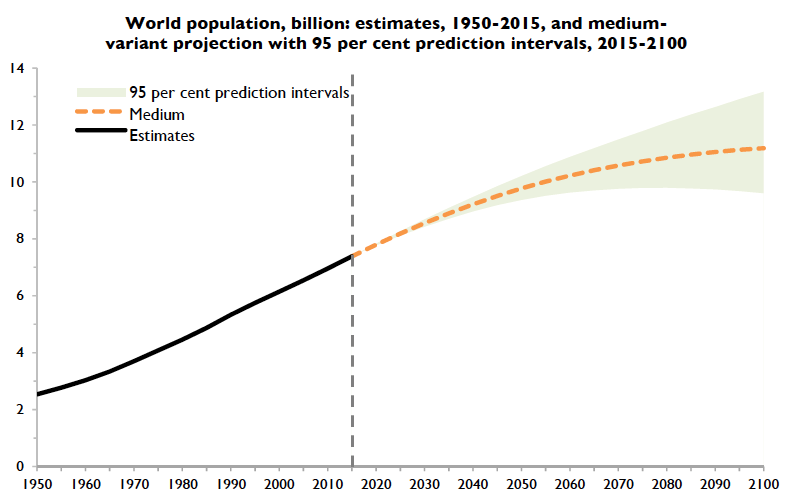
Clearly world population is up by 1 billion not ‘every’ eight years, but over the next 13 years. After 2030 it will take a further 20 years for population to rise by 1.2 billion; after 2050, it will take half a century for population to rise by 1.4 billion.
Alarmist exaggerations of population growth reflect Western fears. The West fears being overwhelmed by Africa’s exploding cities, African immigration, and, long term, by populous China and Asia. In this simplistic framework, population increase is seen not as an opportunity to bring more brains and skilled designers into the world economy, but as a burden on ‘only one Earth’.
In the lurid but also highly limited Green imagination, the finite supply of natural resources is threatened by the demand of too many mouths to feed, each of them consuming too many goods. Importantly, too, no clear role is assigned to technological development of the economy, for labour, or for design, unless all three are directed simply at reducing humanity’s use of resources.
The Malthusian view of population is common nowadays. (10) Moreover Malthusian design projects are widespread in Africa, where design initiatives led by the United Nations, the EU and others are strongly orientated to ‘family planning’. Thus, in Zambia, the design firm IDEO works with the World Design Organization to lower fertility rates. One of IDEO’s leaders gives the example of IDEO
‘transforming a drab, traditional clinic into an accessible and inviting pop-up “Diva Centre” in Zambia, where teenage girls paint their nails while informally receiving information about sexual health. By taking a human-centered approach, spending weeks immersed in and understanding the lives and aspirations of Zambian teens, she said IDEO.org was able to increase the number of girls receiving family planning services through a multi-touch point approach [sic]. Working with Marie Stopes Zambia, IDEO.org has since launched three Diva Centres around Lusaka, which are serving more than 5,000 girls getting them the contraception they need. A staggering 82% of them have adopted some form of birth control, most for the first time’. (11)
One might think that design’s priorities in Africa ought to lie with large-scale endeavours, with the electrification of organisations as much as of households, and with the irrigation, mechanisation and digitalisation of agriculture. (12) But these things turn out not to be the priorities of design missionaries headquartered in Palo Alto, California (IDEO) and Montreal, Quebec (WDO). They are much more interested in curbing fertility among a few thousand African women than they are in putting design at the service of African development.
How long before the institutions of the international design community bring carefully designed family planning services to Poland?
Myth 3: Citizens of ‘developed countries’ feel satiated
This is a claim so extraordinary, it can only be made out of ignorance. Who is to define satiation? How is the feeling of satiation to be measured? How can it be measured in a neutral manner – one that does not, by accident or design, push survey respondents toward a foregone conclusion? Few have tried to answer these questions. In place of a survey of attitudes, then, one must make do with simple, empirical statistics.
Take a simple chore such as washing dishes at home. Not all, but certainly many people would prefer to get that job done automatically, with a dishwashing machine. Yet if we look at a developed economy such as Britain’s, we find that fewer than half the population has a dishwasher: (13)
UK dishwasher ownership, 1994-2017
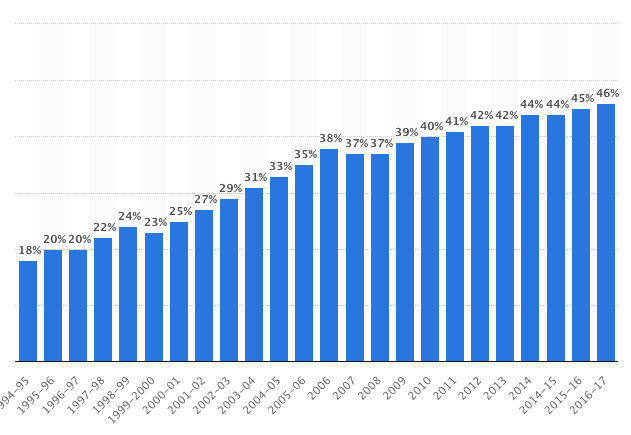
Clearly British demand for dishwashers is far from satiated. About 93 per cent of British households have a microwave oven, and 97 per cent, a washing machine; but just 56 per cent have a tumble dryer, down from 59 per cent in 2008. (14)
It isn’t hard to see why some people don’t have dishwashers. Ownership is strongly stratified by income: (15)
UK dishwasher ownership in 2017, by income decile
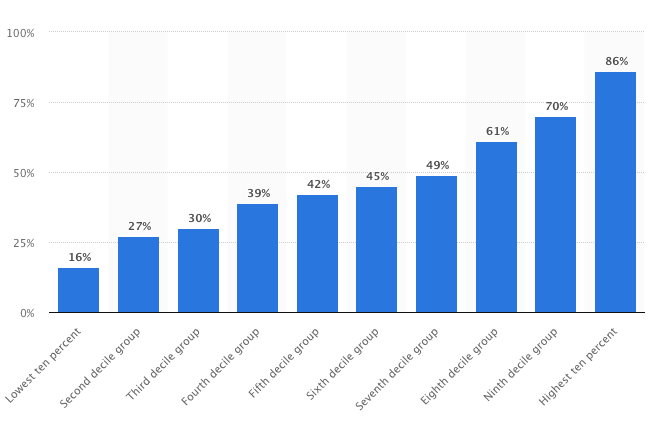
So: the ownership of domestic appliances, and a supposed or inferred mass satiation with those kinds of products, are not simply a consequence of the Earth’s finite resources and humanity’s insatiable demands. Even in common ‘white goods’, ownership levels depend on social class. We can be sure that, in a housing- and class-obsessed country such as Britain, the space available in British homes is also strongly determined by social class.
These dynamics are all very different from the misanthropic visions of a planet beset by omnivorous human beings – greedy, unthinking creatures who need their behaviours reformed by some designerly nudging. (16)
Just as such visions underrate technology, labour and design in economic development, so they have little place for the very real issue of social inequality. To its credit, the Theme for Fair Design does acknowledge growing social stratification, as well as poverty, homelessness and famine. But it explains these phenomena by saying that what ‘breeds’ shortages is… excess.
As a theory, that won’t do. Excess, by itself, cannot explain everything.
So one-dimensional is a political economy built upon the concept of ‘excess’ that it denounces countries that have experienced famine – presumably Ethiopia, Bangladesh, North Korea, Somalia, Yemen, South Sudan and north-eastern Nigeria – for allowing their subsequent fears of shortages to make them mistakenly go ‘creating artificial excess’. Meanwhile, the powerful concept of excess paints developed consumer societies – presumably Britain, and no doubt Poland – as victims of ‘oversatiety’, and as dealing with their excess through ‘reduction, re-using, selection, elimination, slow-life, minimalism, and conscious restriction of consumption’. (17)
Such tactics may signal virtue on the part of both designers and consumers. But for most designers, a more relevant point of departure is to ask: for what kind of people and homes should dishwashers, say, be designed? In the UK, many households without a dishwasher are led or exclusively occupied by a single adult. (18) So there must be a market for inexpensive compact dishwashers. That kind of humanistic consideration, more than moralistic indictments of ‘excess’, is what will really determine the future of consumer goods design.
In fact, the idea that we have an excess of consumer goods in the home has been going, in America, for more than 50 years. (19) For designers to repeat it now, as a unique and novel discovery by People Who Have Seen The Light, is boring, patronizing and silly.
Myth 4: There’s unlimited access to information and services, which makes us helpless
Clearly some designers live in a bubble. It is a bubble where consumption is over the top, and one in which everyone has IT and IT-based services at their fingertips. With an overproduction of information and services, we’re apparently ‘helpless in the face of the vast quantities we are unable to consume or process’.
But access to information and services is far from unlimited. The world has 200 million unemployed, many of whom cannot easily afford much IT. Hundreds of millions of Africans are without electricity, let alone IT.
After four years, Facebook has abandoned efforts to use high-altitude, solar-powered drones, 42 metres in wingspan, to provide laser-guided internet access to remote corners of the world. (20) Hopes of bringing the Internet to remote areas now rest with initiatives such as Alphabet’s Project Loon, which, after Hurricane Maria devastated Puerto Rico, used stratospheric balloons to provide basic Internet service to 200,000 people on the island. (21) For the moment, though, the number of Internet users around the world is still well below half the world’s population: (22)
Number of Internet users, world, 2005-2017
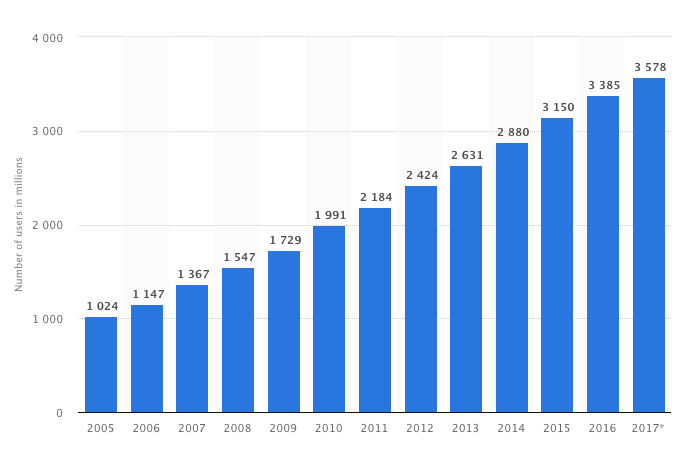
As for the concept of people being overwhelmed by information, it is an old one. Since Alvin Toffler first popularised the idea of information overload back in 1970, the doctrine that human beings can’t cope with the results of IT has become commonplace. From Richard Saul Wurman (Information anxiety, 1989) through to David Shenk (Data smog: surviving the information glut, 1997), designers and commentators have fretted about How The Screens Of Stuff Before Us Have All become Too Much.
Yet we have survived. We have survived even the kind of impressionism that loses its cool at an email Inbox brimming with excess, an Inbox that we lack the wit to handle.
‘Information overload’ is not a very convincing portrait of society. But it certainly demeans people.
Myth 5: Short shelf-lives are forever pushing aside those that are built to last
Next to our supposed excess of information is the idea that we don’t just have too many goods; we have too many ‘new’ goods, where the new is questionable and bogus. In particular, innovation can prove to be fake if the product at issue doesn’t last, either physically or in terms of fashion.
Hostility to meretricious innovation begins in Britain, with the Romantic reaction to the growth of industrially made goods. Writers such as William Morris and John Ruskin were aghast at the irrational variegation and dumbing down apparent in a wave of cheap late 19th century products for the masses. However, it was not until after General Motors chief Alfred Sloan introduced the annual model change in 1924 that the debate on what the economist Stuart Chase (The tragedy of waste, 1925) termed ‘harmful and unnecessary goods and services’ really became a popular discussion. (23)
Chase was a follower of Thorstein Veblen. Waste in consumption was particularly evident, he argued, in the military, among narcotics and patent medicines, in crime, in adulterated food, drink, clothing and other necessities, in institutionalised speculation and gambling, in quack medicines, super-luxuries and cheap imitations of those luxuries, in fashions, commercial recreation, professional services and, ‘as a sort of godfather to them all’, in advertising. For Chase, Americans ate ‘too much high cost meat, as against the cheaper and more healthful grains, cheeses, fruits and vegetables’, and the US consumer should be educated accordingly. (24) Chase also repeated, using a Harvard Business Review, July 1924 article on the effect of changes in styles and fashions on the textile industry, the idea that a whim in Paris could very quickly make new fabrics and garments in the US ‘become obsolete and unusable’. (25)
As Maria Szolc notes in her conference paper on An excess of clothing, the average UK family throws away as much as 30 kilos of clothes each year. But as Chase pointed out, the old English Fabians, Sidney and Beatrice Webb, long ago complained about a matron with 79 nightgowns and an average of five changes of clothes a day. (26) Is, then, the wardrobe that’s stuffed full of ‘nothing to wear’ merely one more example of a longstanding and universal trend: planned obsolescence? No. Is it a phenomenon that establishes the basic dynamics of what we are told is a consumer society? Hardly.
From Chase, through Vance Packard (The wastemakers, 1960), Ivan Illich (Tools for conviviality, 1973) and Giles Slade (Made to break: technology and obsolescence in America, 2007), the idea of planned obsolescence has resonated way beyond its actual practice. (27) One relatively recent theorist of planned obsolescence begins an article on the subject with pure assertion: obsolescence, he says, is ‘the economic and cultural foundation of capitalism in general and of its distinctive variety of market driven consumption in particular’. (28) But what is the truth? There is little real evidence for a systemic reliance, on the part of capitalism, upon product obsolescence as a means of sustaining consumer demand. The masses are not being manipulated into buying the Next Big Feature That They Don’t Need.
Take Amazon. Since its birth in 1994, Amazon has renewed the forces of competition in consumer goods. But the competition is not one firm outdoing another through planned obsolescence. What Amazon has unleashed is old-fashioned rivalry on the basis of price.
Far from becoming obsolete fast, many products now have a longer life than ever. In late 2016, IHS Markit Automotive reported that the average age of light vehicles in operation in the US had once again climbed, reaching 11.6 years, and that the oldest vehicles on US roads were multiplying the fastest. (29)
In computer games, a sector renowned for its febrile approach to new products, Candy Crush Saga is also a monument to durability. It is still going strong, six years after its launch in 2012.
Even in mobile phones, a sector notorious for making its products obsolete, handset lives are lengthening, not shortening:
‘Back in 2014, the average upgrade cycle [on a mobile phone] was 23 months – likely attributable to most consumers upgrading every two years, while a much smaller number upgraded every year. But that number has already hit 31 months, says BayStreet Research, and is set to climb higher still… The WSJ [Wall Street Journal] cites the firm predicting a 33-month cycle by next year [2019].’ (30)
Of course, capitalism generates a great amount of stupid innovations: in energy, for instance, it has given us ‘smart meters’ and hydrogen-powered vehicles. (31) Capitalism has also long required advertising to make sure innovations are sold on the market, and has created new needs in the process. (32) In her conference paper on FORGOTOR: design for a harmless computer virus, Katarzyna Moszczyńska suggests that we should not create new needs. But who is to judge what is an ‘unnecessary’ product or need? One person’s piece of planned obsolescence may be another’s pure delight. (33)
Some products age quickly, others do not. France and Israel, in their wisdom, have passed laws against planned obsolescence. No doubt some obsolescence could be avoided, and some is just good fun. But if consumption and its encouragement form aspects of today’s economic systems, they are just that: aspects. They do not underpin the economy very much more than energy, agriculture, construction and property, IT, government, corporations, the banks, trade, or science. To say that the obsolescence of consumer goods and services is the ‘foundation’ of modern capitalism is as sweeping as to say that short product lifecycles are ‘forever’ pushing aside long ones. To go back to the humble dishwasher: are we really saying that those British households that lack a dishwasher do so because planned obsolescence has put the price of such a machine beyond their reach? That seems unlikely.
Anyway, whatever happened to machinery, commercial property, transport infrastructure or housing – are they being more and more rapidly replaced, in the mad dash for obsolescence? The current crisis in Western capital investment, infrastructure and housing suggests otherwise.
Myth 6: 20th-century design theories ignored excess
This is a particularly astonishing proposition. Since the publication of Victor Papanek’s Design for the Real World in 1971, the entire focus of international design institutions, and of design education, has been around low-tech design for the environment and for developing countries. The Designers Accord, 2007-12, was committed to biomimicry and sustainability. (34) At the University of the Applied Arts, Vienna, the Papanek Foundation lives on. (35) From Finland, the Nordic Frugal Innovation Society organises conferences and business breakfasts. (36) In the Netherlands the Leiden, Delft and Erasmus universities collaborate, in the Centre for Frugal Innovation in Africa, to ensure that the Dark Continent does not go too far in its use of resources. (37) A key part of the ‘vision and mission’ of the World Design Organization is about achieving the United Nations Sustainable Development Goals. (38) Last, a search of books on Amazon.com using the tightly delimited phrase ’sustainable design’ generates no fewer than 626 results. There is an excess of books about the need to curb excess.
The policy of the EU is all about curbing excess. The EU’s 2009 Directive on the Ecodesign of energy-related products wants consumption of energy, water and other resources lowered throughout the product life cycle. (39) Yet as one of the London Guardian’s more perceptive commentators has recently written,
‘Telling someone with a low-paid, insecure job in a town hollowed out by globalisation that the answer to their problems is a sugar tax, mandatory parenting classes and drinking less has its limitations as a vote-winning strategy.’ (40)
Designers, of course, are not in the business of ‘winning votes’. But before they again wag their fingers at those plebeian elements they think are consuming too much, they should consider what this approach will do for their reputation, and indeed for their survival.
Footnotes and References
1. A recent exception to this rule is Jon Kolko, ‘Enough Design Methods’, The Modernist Studio, 28 May 2018, on http://www.themoderniststudio.com/2018/05/28/enough-design-methods/
2. See ‘Theme’, FairDesign 18, on http://fair-design.pl/en/
3. US Census Bureau, ‘Median and Average Square Feet of Floor Area in New Single-Family Houses Completed by Type of Financing’ https://www.census.gov/construction/chars/pdf/squarefeet.pdf and US Census Bureau, ‘Median and Average Square Feet of Floor Area in Multifamily Units Completed’ https://www.census.gov/construction/chars/pdf/mfu_squarefeet.pdf
4. Robert Booth, ‘“Dog kennel” flats in Barnet will be 40% smaller than Travelodge room’, The Guardian, 27 March 2017, on https://www.theguardian.com/society/2017/mar/27/dog-kennel-flats-barnet-house-smaller-than-travelodge-room
5. LABC Warranty, Are Britain’s Houses Getting Smaller? (New Data), April 2018, on https://www.labcwarranty.co.uk/blog/are-britain-s-houses-getting-smaller-new-data/
6. UBS, quoted in David Marino-Nachison, ‘Food & Dining: Predicting the “Death of the Kitchen”’ , Barrons, 20 June 2018, on https://www.barrons.com/articles/food-dining-predicting-the-death-of-the-kitchen-1529494200
7. Sarah Butler, ‘How Deliveroo’s “dark kitchens” are catering from car parks, The Guardian, 28 October 2017, on https://www.theguardian.com/business/2017/oct/28/deliveroo-dark-kitchens-pop-up-feeding-the-city-london §
8. James Woudhuysen, ‘The future of housing’, Blueprint, December 2017, on www.woudhuysen.com/the-future-of-housing/
9. United Nations, Department of Economic and Social Affairs, Population Division, World Population Prospects: The 2017 Revision, Key Findings and Advance Tables, Working Paper No. ESA/P/WP/248, 2017, on https://esa.un.org/unpd/wpp/Publications/Files/WPP2017_KeyFindings.pdf
10. James Woudhuysen, ‘The silent war against population growth in Africa’, spiked, January 2018, on http://www.woudhuysen.com/silent-war-population-growth-africa/
11. World Design Organization, ‘Design policy conference’, 15 and 16 October 2016, before a crowd of 1500 people, Taipei International Convention Centre, on http://wdo.org/programmes/wdc/past-cities/wdctaipei2016/activities/design-policy-conference/
12. James Woudhuysen, ‘Africa: what would real progress look like?’, November 2017, on www.woudhuysen.com/africa-what-would-real-progress-look-like/
13. Statista, Percentage of households with dishwashers in the United Kingdom (UK) from 1994 to 2017, 2018, on https://www.statista.com/statistics/289151/household-dishwashing-in-the-uk/
14. Statista, Percentage of households with microwave ovens in the United Kingdom (UK) from 1994 to 2016, 2018, on https://www.statista.com/statistics/289155/household-microwave-penetration-in-the-uk/; Percentage of households with washing machines in the United Kingdom (UK) from 1970 to 2017, 2018, https://www.statista.com/statistics/289017/washing-machine-ownership-in-the-uk/
Percentage of households with tumble dryers in the United Kingdom (UK) from 1995 to 2017, 2018, on https://www.statista.com/statistics/289140/tumble-dryers-in-households-in-the-uk/
15. Statista, Percentage of households with s dishwasher in the United Kingdom (UK) in 2017, by gross income group, 2018, on https://www.statista.com/statistics/289281/household-dishwashers-in-the-uk-by-income-group/
16. The UK’s Behavioural Design Lab, a partnership between Warwick Business School and the Design Council, 2012-5, laid particular emphasis on changing people’s behaviour in relation to the environment. See https://www.behaviouraldesignlab.org
17. See ‘Theme’, FairDesign 18, on http://fair-design.pl/en/
18. Statista, Percentage of households with a dishwasher in the United Kingdom (UK) in 2017, by household composition, 2018, on https://www.statista.com/statistics/289337/distribution-of-dishwashers-in-the-uk-by-household-composition/
19. See for example Betty Friedan, The feminine mystique (1963), Pelican Books, 1983, and Staffan Burenstam Linder, The harried leisure class, Columbia University Press, 1969.
20. Katyanna Quach, ‘Facebook quietly kills its Aquila autonomous internet drone program’, The Register, 27 June 2018, on https://www.theregister.co.uk/2018/06/27/facebook_kills_aquila/
21. Amy Nordrum, ‘How Project Loon built the navigation system that kept its balloons over Puerto Rico’, IEEE Spectrum, 8 March 2018, on https://spectrum.ieee.org/tech-talk/telecom/internet/how-project-loon-built-the-navigation-system-that-kept-its-balloons-over-puerto-rico
22. Statista, Number of internet users worldwide from 2005 to 2017 (in millions), 2018, on https://www.statista.com/statistics/273018/number-of-internet-users-worldwide/
23. Stuart Chase, The tragedy of waste (1925), Macmillan, 1929, p27, on https://babel.hathitrust.org/cgi/pt?id=coo.31924002234544;view=1up;seq=40 The year 1924 was also important in that the Phoebus cartel of manufacturers of light-bulbs – Germany’s Osram, France’s Compagnie des Lampes, Holland’s Philips and America’s General Electric agreed not just the fixing of prices, but also a limit on the lifetime of their products: 1000 hours. Ever since, the view that planned obsolescence is a shadowy conspiracy has gained credence.
24. Ibid, pp31, 32.
25. Ibid, p93, my emphasis. Misspelling his name as Cherrington, Chase cited Dr Paul T Cherington, Harvard Business Review, July 1924. The article is ‘Some commercial aspects of styles and fashions in the clothing and textile industries’, pp421-433.
26. Ibid, p90.
27. For a treatment of Veblen, Hobson, Keynes, Galbraith, Packard and Illich, see James Woudhuysen and Joe Kaplinsky, Energise! A future for energy innovation, Beautiful Books, 2009, pp 76-84, on http://www.woudhuysen.com/wp-content/uploads/2015/08/energise.pdf
28. Neil Maycroft, ‘Consumption, planned obsolescence and waste’, 2009, on http://eprints.lincoln.ac.uk/2062/1/Obsolescence.pdf
29. IHS Markit, ‘Vehicles getting older: average age of light cars and trucks in US rises again in 2016 to 11.6 years, IHS Markit Says’, 22 November 2016, on http://news.ihsmarkit.com/press-release/automotive/vehicles-getting-older-average-age-light-cars-and-trucks-us-rises-again-201
30. Ben Lovejoy, ‘Longer upgrade cycles and growing purchases of used smartphones said to threaten iPhone sales’, 9to5Mac, 1 March 2018, https://9to5mac.com/2018/03/01/iphone-sales-threats/
31. See James Woudhuysen, ‘Innovation in energy: expressions of a crisis, and some ways forward’, Energy & Environment, Special issue on innovation in energy, Vol 23 No 6&7, 2012, pp957-61, on www.woudhuysen.com/wp-content/uploads/2015/01/Innovation-in-Energy-2012.pdf
32. The capitalist ‘searches for means’ to spur consumers ‘on to consumption, to give his wares new charms, to inspire them with new needs by constant chatter etc’. Karl Marx, ‘Notebook II – the chapter on capital’, Grundrisse [1857], on https://www.marxists.org/archive/marx/works/1857/grundrisse/ch05.htm#p284
33. For the record, Marx had a liberal and indeed enthusiastic attitude toward new needs. He famously wrote that their creation – ‘precisely this side of the relation of capital and labour’ – was ‘an essential civilising moment’. Indeed the creation of new needs was for Marx the ‘historic justification’ of capital, and also ‘the basis for its contemporary power’. Ibid. Equally, capital’s tendency was for Marx ‘the transformation of what was previously superfluous into what is necessary, as a historically created necessity’. Ibid, and Marx, ‘Notebook V – the chapter on capital’, Grundrisse [1857], on https://www.marxists.org/archive/marx/works/1857/grundrisse/ch10.htm
34. See http://www.designersaccord.org
35. See http://papanek.org
36. See https://tnfis.org
37. See http://www.cfia.nl/home
38. See http://wdo.org/about/vision-mission/un-sdgs/
39. ‘Directive 2009/125/EC of the European Parliament and of the Council of 21 October 2009 establishing a framework for the setting of ecodesign requirements for energy-related products’, Official Journal of the European Union, 30 October 2009, Annex 1, p23, on https://eur-lex.europa.eu/legal-content/EN/TXT/PDF/?uri=CELEX:32009L0125&from=EN
40. Larry Elliott, ‘Labour: you need to win hearts and minds in our low-wage towns’, The Guardian, 4 July 2018, on https://www.theguardian.com/commentisfree/2018/jul/04/labour-low-wage-jeremy-corbyn-policies-leave-voters
@jameswoudhuysen I use my bicycle every day. Exercise and access to shopping without any parking meters and all that fuzz. But alfa-cyclists are the worst. They are competing at 40 mph and always acting rudely to get where they are going.
A PRO-CAR CYCLIST WRITES: 12-1pm tomorrow on #R4, will be talking bikes, cars, pedestrians, public transport – and #JeremyVine
Stimulating piece on the #CrisisOfCustomerService by clever @ClaerB @FT.
All that Clinton-era #CustomerExperience guff was always for the birds - certainly compared with, er, price.
The new thang? Often there is NO service - and thus no #CX!
Articles grouped by Tag
Bookmarks
Innovators I like

Robert Furchgott – discovered that nitric oxide transmits signals within the human body

Barry Marshall – showed that the bacterium Helicobacter pylori is the cause of most peptic ulcers, reversing decades of medical doctrine holding that ulcers were caused by stress, spicy foods, and too much acid

N Joseph Woodland – co-inventor of the barcode

Jocelyn Bell Burnell – she discovered the first radio pulsars

John Tyndall – the man who worked out why the sky was blue

Rosalind Franklin co-discovered the structure of DNA, with Crick and Watson

Rosalyn Sussman Yallow – development of radioimmunoassay (RIA), a method of quantifying minute amounts of biological substances in the body

Jonas Salk – discovery and development of the first successful polio vaccine

John Waterlow – discovered that lack of body potassium causes altitude sickness. First experiment: on himself

Werner Forssmann – the first man to insert a catheter into a human heart: his own

Bruce Bayer – scientist with Kodak whose invention of a colour filter array enabled digital imaging sensors to capture colour

Yuri Gagarin – first man in space. My piece of fandom: http://www.spiked-online.com/newsite/article/10421

Sir Godfrey Hounsfield – inventor, with Robert Ledley, of the CAT scanner

Martin Cooper – inventor of the mobile phone

Thomas Tuohy – Windscale manager who doused the flames of the 1957 fire

Eugene Polley – TV remote controls

George Devol – 'father of robotics’ who helped to revolutionise carmaking



0 comments